ACCT6007 - Financial Accounting: Fair Value Analysis Report
VerifiedAdded on 2023/06/03
|12
|2444
|348
Report
AI Summary
This report presents a critical analysis of Antonio Marra's article on fair value accounting. The analysis begins with an introduction to fair value measurement and its application in accounting. It then delves into a literature review of the article, detailing the pros and cons of fair value accounting. The report further explains the three-tier process used in fair value measurement and examines the qualitative characteristics of financial statements related to fair value. Additionally, it explores variables influencing the significance and representational faithfulness of fair value information. The report concludes with an assessment of the discussed topics.

Running head: ANALYSIS ON FINANCIAL ACCOUNTING AND REPORTING
Analysis on Financial Accounting and Reporting
Name of the Student:
Name of the University:
Author Note:
Analysis on Financial Accounting and Reporting
Name of the Student:
Name of the University:
Author Note:
Paraphrase This Document
Need a fresh take? Get an instant paraphrase of this document with our AI Paraphraser

1ANALYSIS ON FINANCIAL ACCOUNTING AND REPORTING
Table of Contents
Introduction......................................................................................................................................3
Literature Review............................................................................................................................4
Pros and Cons of Fair Value (FV) Accounting...........................................................................4
Pros of Fair Value Accounting................................................................................................4
Cons of Fair Value Accounting...............................................................................................5
Three- Tier Process......................................................................................................................6
Qualitative Characteristics of Financial Statement related to Fair Value Measurement.............7
Variables Inducing the Significance and Representative Faithfulness of Fair Value
Information..............................................................................................................................7
Conclusion.......................................................................................................................................8
Reference:........................................................................................................................................8
Table of Contents
Introduction......................................................................................................................................3
Literature Review............................................................................................................................4
Pros and Cons of Fair Value (FV) Accounting...........................................................................4
Pros of Fair Value Accounting................................................................................................4
Cons of Fair Value Accounting...............................................................................................5
Three- Tier Process......................................................................................................................6
Qualitative Characteristics of Financial Statement related to Fair Value Measurement.............7
Variables Inducing the Significance and Representative Faithfulness of Fair Value
Information..............................................................................................................................7
Conclusion.......................................................................................................................................8
Reference:........................................................................................................................................8
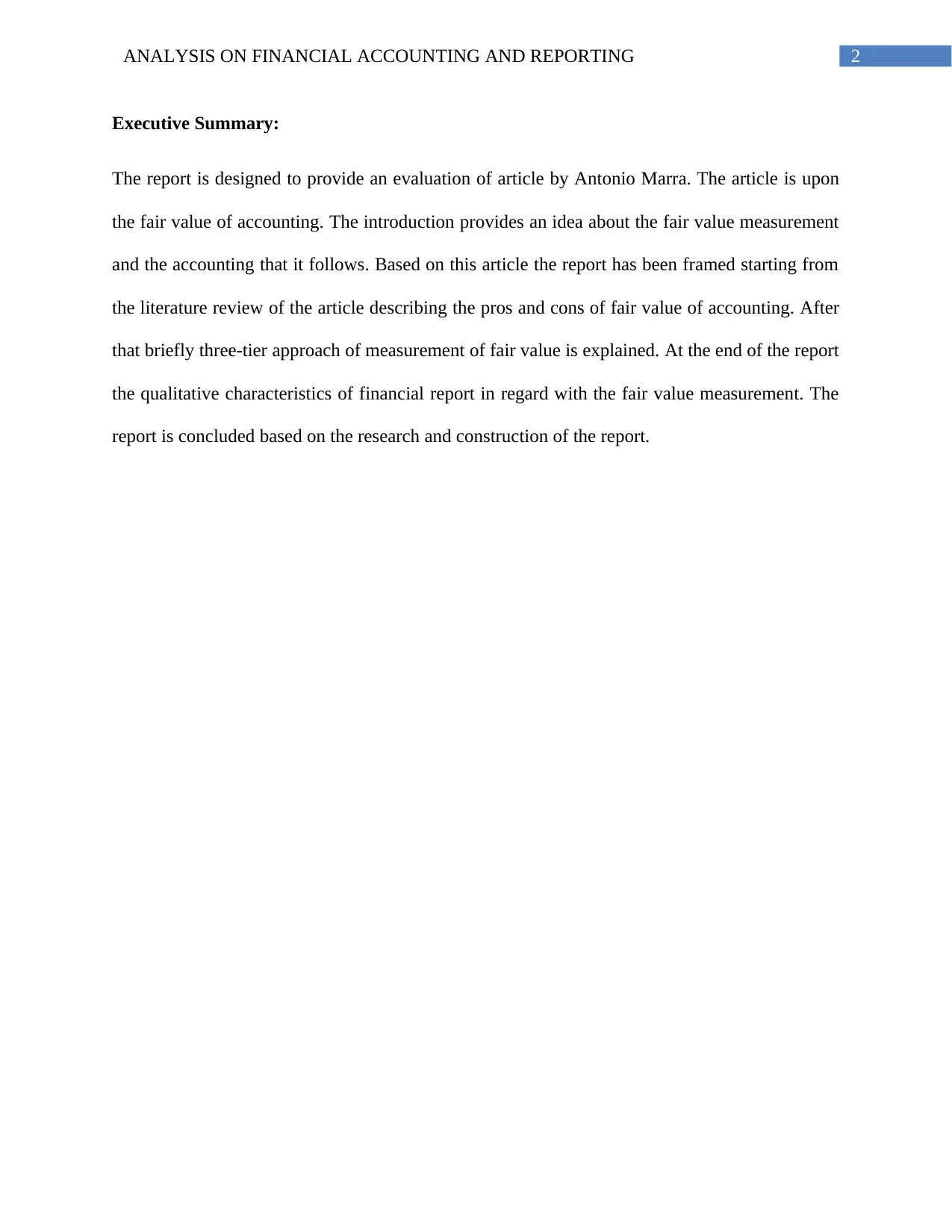
2ANALYSIS ON FINANCIAL ACCOUNTING AND REPORTING
Executive Summary:
The report is designed to provide an evaluation of article by Antonio Marra. The article is upon
the fair value of accounting. The introduction provides an idea about the fair value measurement
and the accounting that it follows. Based on this article the report has been framed starting from
the literature review of the article describing the pros and cons of fair value of accounting. After
that briefly three-tier approach of measurement of fair value is explained. At the end of the report
the qualitative characteristics of financial report in regard with the fair value measurement. The
report is concluded based on the research and construction of the report.
Executive Summary:
The report is designed to provide an evaluation of article by Antonio Marra. The article is upon
the fair value of accounting. The introduction provides an idea about the fair value measurement
and the accounting that it follows. Based on this article the report has been framed starting from
the literature review of the article describing the pros and cons of fair value of accounting. After
that briefly three-tier approach of measurement of fair value is explained. At the end of the report
the qualitative characteristics of financial report in regard with the fair value measurement. The
report is concluded based on the research and construction of the report.
⊘ This is a preview!⊘
Do you want full access?
Subscribe today to unlock all pages.

Trusted by 1+ million students worldwide

3ANALYSIS ON FINANCIAL ACCOUNTING AND REPORTING
Introduction
Fair value accounting is a financial reporting method in which businesses are compulsory
or allowed to amount and bang on an enduring basis, convinced assets and liabilities those are
generally financial instruments at guesses of the prices they would obtain if they were to vend
the assets or would reimburse if they were to be reassured of the liabilities. Under fair value
accounting, corporations boom losses when the fair morals of their assets reduces or liabilities
rises. Those losses decrease companies’ testified equity and may decrease companies’ conveyed
net income. Though fair values have played, a character in U.S. GAAP more than 50 years,
accounting standards those require or gives permission that fair value accounting have increase
figure and implication in current years. The report explains the various pros and cons of fair
value of accounting identified by the author. In the other parts of the report three-tier process of
the accounting is being explained followed with the analysis of quantitative characteristics of
financial statement components based upon the fair value measurement
Literature Review
The article of Marra, (2016) stated about the Fair Value of Accounting. The way the
concept was brought into use in this global economy. The author explained the pros and cons of
the fair value, which is the current topic on which both IAS and IFRS are trying to come up with
the applicable use and way. As the fair value, method of accounting is being applied since
decades its importance has been increasing in the accounting standards. Through the article, it
was pointed out the unescapable occupation-off among the significance and dependability of
accounting standards. ( Marra, 2016).
Introduction
Fair value accounting is a financial reporting method in which businesses are compulsory
or allowed to amount and bang on an enduring basis, convinced assets and liabilities those are
generally financial instruments at guesses of the prices they would obtain if they were to vend
the assets or would reimburse if they were to be reassured of the liabilities. Under fair value
accounting, corporations boom losses when the fair morals of their assets reduces or liabilities
rises. Those losses decrease companies’ testified equity and may decrease companies’ conveyed
net income. Though fair values have played, a character in U.S. GAAP more than 50 years,
accounting standards those require or gives permission that fair value accounting have increase
figure and implication in current years. The report explains the various pros and cons of fair
value of accounting identified by the author. In the other parts of the report three-tier process of
the accounting is being explained followed with the analysis of quantitative characteristics of
financial statement components based upon the fair value measurement
Literature Review
The article of Marra, (2016) stated about the Fair Value of Accounting. The way the
concept was brought into use in this global economy. The author explained the pros and cons of
the fair value, which is the current topic on which both IAS and IFRS are trying to come up with
the applicable use and way. As the fair value, method of accounting is being applied since
decades its importance has been increasing in the accounting standards. Through the article, it
was pointed out the unescapable occupation-off among the significance and dependability of
accounting standards. ( Marra, 2016).
Paraphrase This Document
Need a fresh take? Get an instant paraphrase of this document with our AI Paraphraser
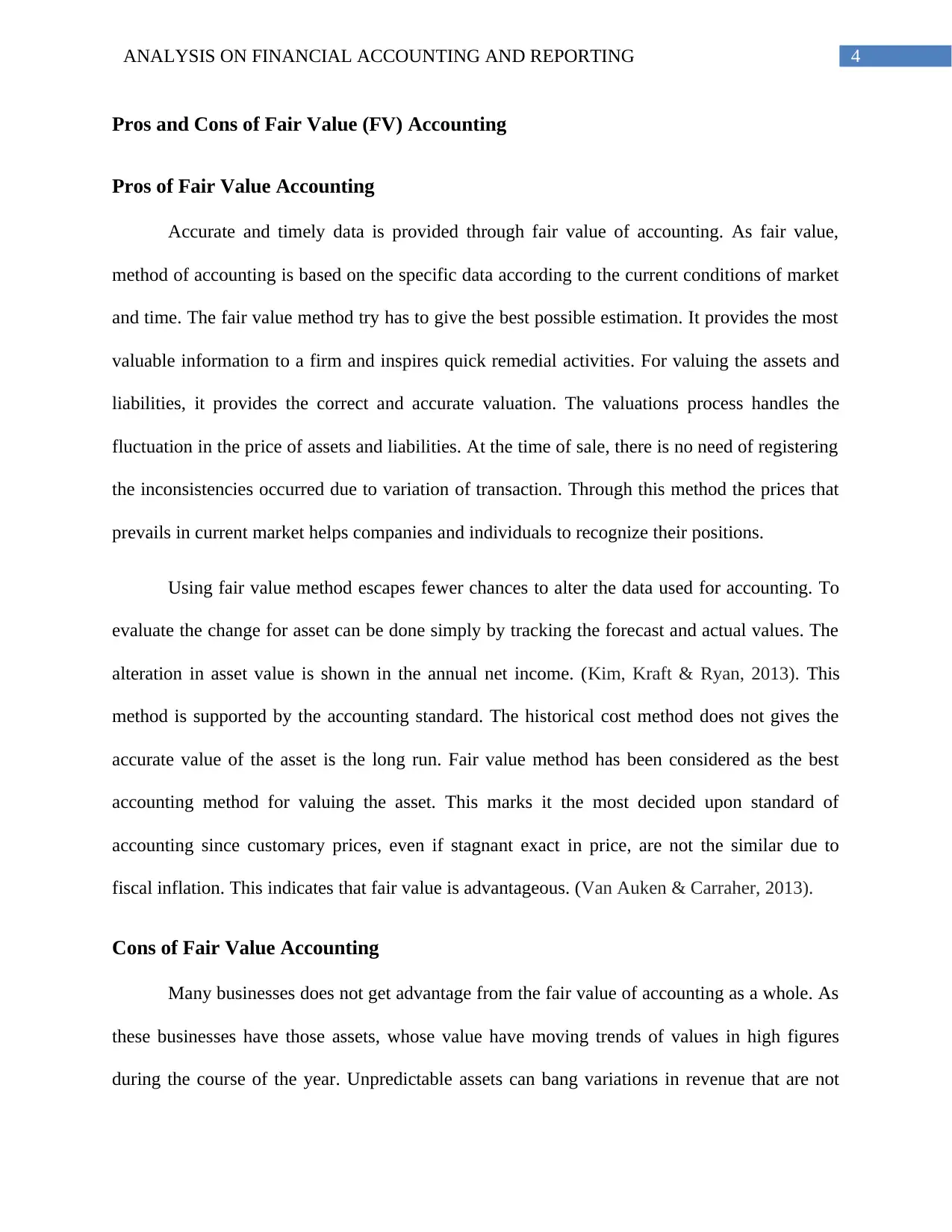
4ANALYSIS ON FINANCIAL ACCOUNTING AND REPORTING
Pros and Cons of Fair Value (FV) Accounting
Pros of Fair Value Accounting
Accurate and timely data is provided through fair value of accounting. As fair value,
method of accounting is based on the specific data according to the current conditions of market
and time. The fair value method try has to give the best possible estimation. It provides the most
valuable information to a firm and inspires quick remedial activities. For valuing the assets and
liabilities, it provides the correct and accurate valuation. The valuations process handles the
fluctuation in the price of assets and liabilities. At the time of sale, there is no need of registering
the inconsistencies occurred due to variation of transaction. Through this method the prices that
prevails in current market helps companies and individuals to recognize their positions.
Using fair value method escapes fewer chances to alter the data used for accounting. To
evaluate the change for asset can be done simply by tracking the forecast and actual values. The
alteration in asset value is shown in the annual net income. (Kim, Kraft & Ryan, 2013). This
method is supported by the accounting standard. The historical cost method does not gives the
accurate value of the asset is the long run. Fair value method has been considered as the best
accounting method for valuing the asset. This marks it the most decided upon standard of
accounting since customary prices, even if stagnant exact in price, are not the similar due to
fiscal inflation. This indicates that fair value is advantageous. (Van Auken & Carraher, 2013).
Cons of Fair Value Accounting
Many businesses does not get advantage from the fair value of accounting as a whole. As
these businesses have those assets, whose value have moving trends of values in high figures
during the course of the year. Unpredictable assets can bang variations in revenue that are not
Pros and Cons of Fair Value (FV) Accounting
Pros of Fair Value Accounting
Accurate and timely data is provided through fair value of accounting. As fair value,
method of accounting is based on the specific data according to the current conditions of market
and time. The fair value method try has to give the best possible estimation. It provides the most
valuable information to a firm and inspires quick remedial activities. For valuing the assets and
liabilities, it provides the correct and accurate valuation. The valuations process handles the
fluctuation in the price of assets and liabilities. At the time of sale, there is no need of registering
the inconsistencies occurred due to variation of transaction. Through this method the prices that
prevails in current market helps companies and individuals to recognize their positions.
Using fair value method escapes fewer chances to alter the data used for accounting. To
evaluate the change for asset can be done simply by tracking the forecast and actual values. The
alteration in asset value is shown in the annual net income. (Kim, Kraft & Ryan, 2013). This
method is supported by the accounting standard. The historical cost method does not gives the
accurate value of the asset is the long run. Fair value method has been considered as the best
accounting method for valuing the asset. This marks it the most decided upon standard of
accounting since customary prices, even if stagnant exact in price, are not the similar due to
fiscal inflation. This indicates that fair value is advantageous. (Van Auken & Carraher, 2013).
Cons of Fair Value Accounting
Many businesses does not get advantage from the fair value of accounting as a whole. As
these businesses have those assets, whose value have moving trends of values in high figures
during the course of the year. Unpredictable assets can bang variations in revenue that are not
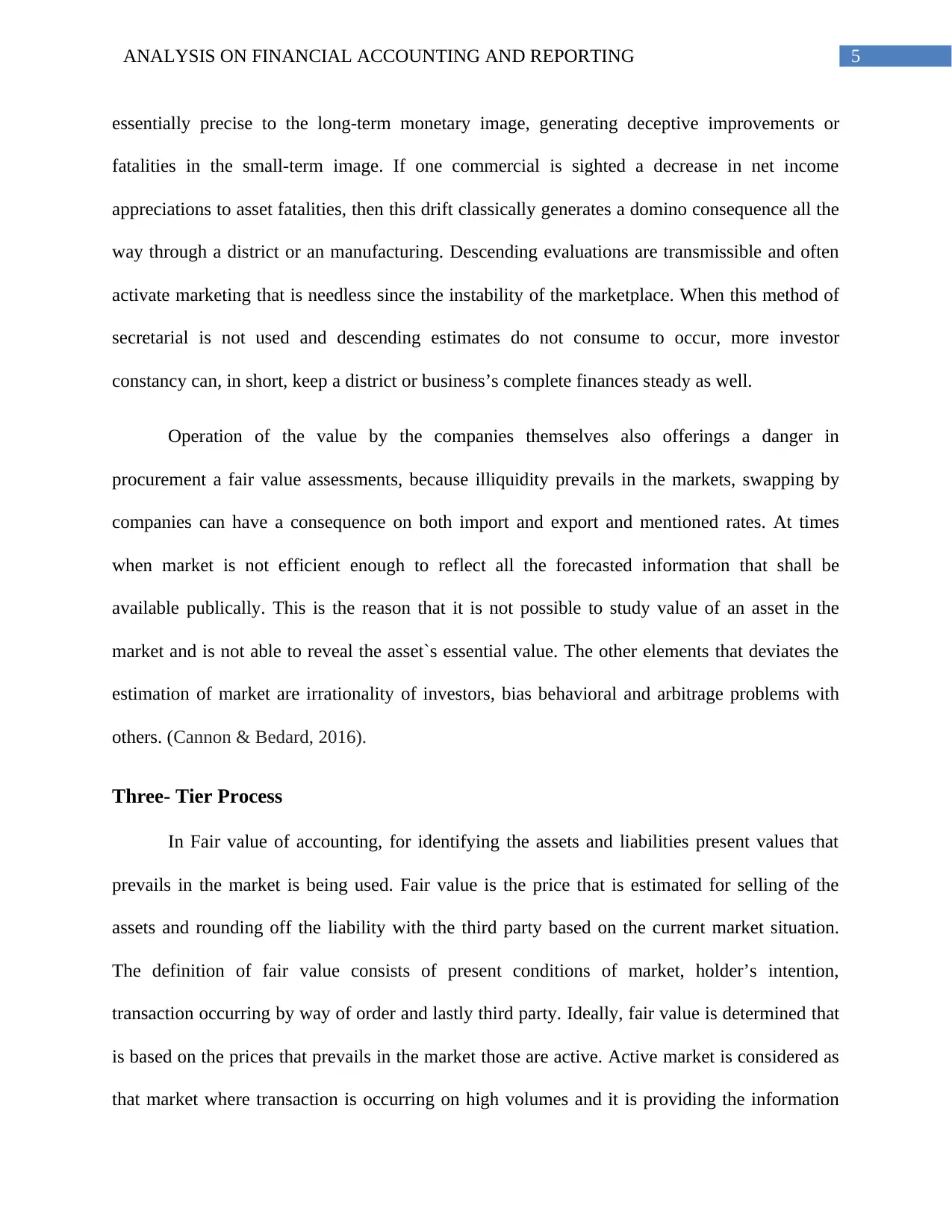
5ANALYSIS ON FINANCIAL ACCOUNTING AND REPORTING
essentially precise to the long-term monetary image, generating deceptive improvements or
fatalities in the small-term image. If one commercial is sighted a decrease in net income
appreciations to asset fatalities, then this drift classically generates a domino consequence all the
way through a district or an manufacturing. Descending evaluations are transmissible and often
activate marketing that is needless since the instability of the marketplace. When this method of
secretarial is not used and descending estimates do not consume to occur, more investor
constancy can, in short, keep a district or business’s complete finances steady as well.
Operation of the value by the companies themselves also offerings a danger in
procurement a fair value assessments, because illiquidity prevails in the markets, swapping by
companies can have a consequence on both import and export and mentioned rates. At times
when market is not efficient enough to reflect all the forecasted information that shall be
available publically. This is the reason that it is not possible to study value of an asset in the
market and is not able to reveal the asset`s essential value. The other elements that deviates the
estimation of market are irrationality of investors, bias behavioral and arbitrage problems with
others. (Cannon & Bedard, 2016).
Three- Tier Process
In Fair value of accounting, for identifying the assets and liabilities present values that
prevails in the market is being used. Fair value is the price that is estimated for selling of the
assets and rounding off the liability with the third party based on the current market situation.
The definition of fair value consists of present conditions of market, holder’s intention,
transaction occurring by way of order and lastly third party. Ideally, fair value is determined that
is based on the prices that prevails in the market those are active. Active market is considered as
that market where transaction is occurring on high volumes and it is providing the information
essentially precise to the long-term monetary image, generating deceptive improvements or
fatalities in the small-term image. If one commercial is sighted a decrease in net income
appreciations to asset fatalities, then this drift classically generates a domino consequence all the
way through a district or an manufacturing. Descending evaluations are transmissible and often
activate marketing that is needless since the instability of the marketplace. When this method of
secretarial is not used and descending estimates do not consume to occur, more investor
constancy can, in short, keep a district or business’s complete finances steady as well.
Operation of the value by the companies themselves also offerings a danger in
procurement a fair value assessments, because illiquidity prevails in the markets, swapping by
companies can have a consequence on both import and export and mentioned rates. At times
when market is not efficient enough to reflect all the forecasted information that shall be
available publically. This is the reason that it is not possible to study value of an asset in the
market and is not able to reveal the asset`s essential value. The other elements that deviates the
estimation of market are irrationality of investors, bias behavioral and arbitrage problems with
others. (Cannon & Bedard, 2016).
Three- Tier Process
In Fair value of accounting, for identifying the assets and liabilities present values that
prevails in the market is being used. Fair value is the price that is estimated for selling of the
assets and rounding off the liability with the third party based on the current market situation.
The definition of fair value consists of present conditions of market, holder’s intention,
transaction occurring by way of order and lastly third party. Ideally, fair value is determined that
is based on the prices that prevails in the market those are active. Active market is considered as
that market where transaction is occurring on high volumes and it is providing the information
⊘ This is a preview!⊘
Do you want full access?
Subscribe today to unlock all pages.

Trusted by 1+ million students worldwide
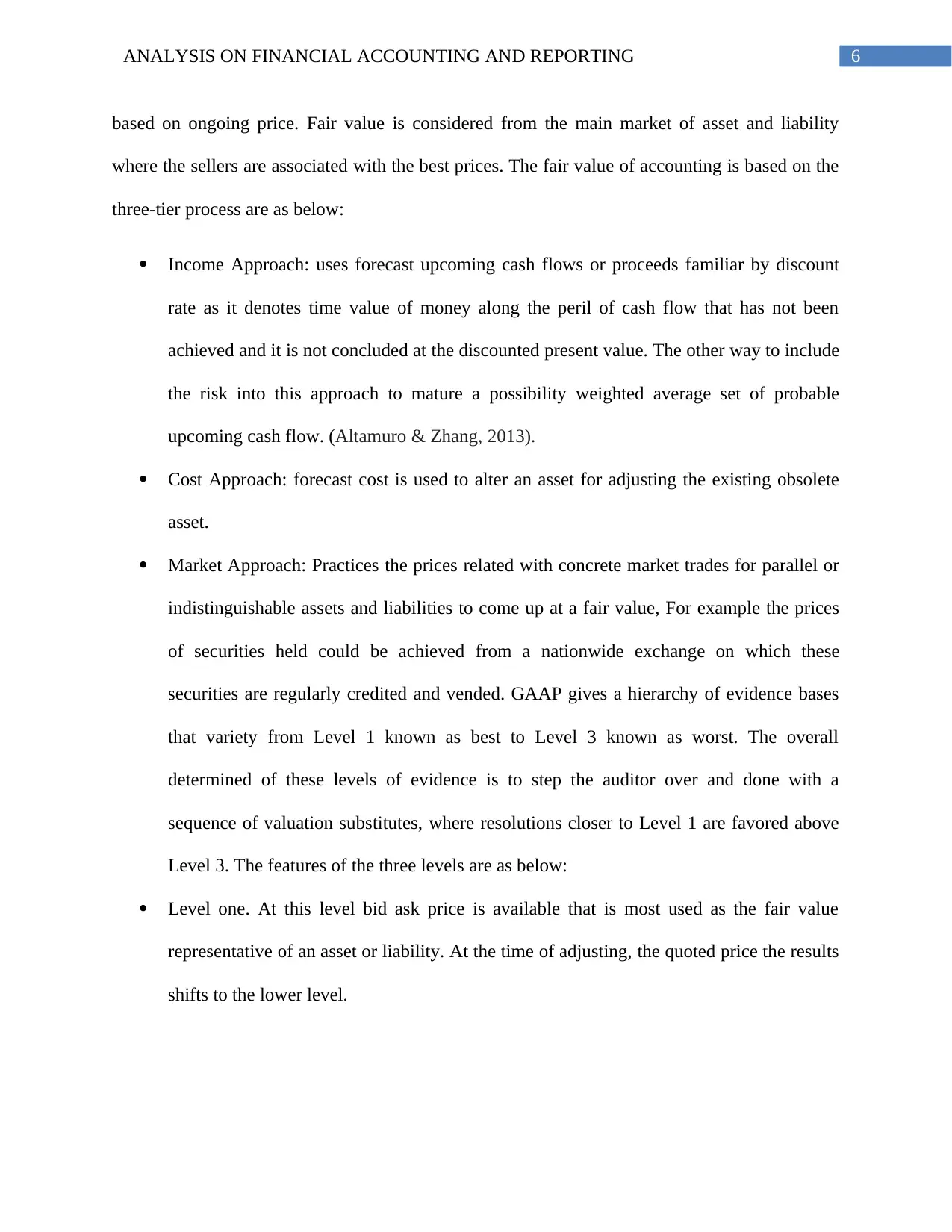
6ANALYSIS ON FINANCIAL ACCOUNTING AND REPORTING
based on ongoing price. Fair value is considered from the main market of asset and liability
where the sellers are associated with the best prices. The fair value of accounting is based on the
three-tier process are as below:
Income Approach: uses forecast upcoming cash flows or proceeds familiar by discount
rate as it denotes time value of money along the peril of cash flow that has not been
achieved and it is not concluded at the discounted present value. The other way to include
the risk into this approach to mature a possibility weighted average set of probable
upcoming cash flow. (Altamuro & Zhang, 2013).
Cost Approach: forecast cost is used to alter an asset for adjusting the existing obsolete
asset.
Market Approach: Practices the prices related with concrete market trades for parallel or
indistinguishable assets and liabilities to come up at a fair value, For example the prices
of securities held could be achieved from a nationwide exchange on which these
securities are regularly credited and vended. GAAP gives a hierarchy of evidence bases
that variety from Level 1 known as best to Level 3 known as worst. The overall
determined of these levels of evidence is to step the auditor over and done with a
sequence of valuation substitutes, where resolutions closer to Level 1 are favored above
Level 3. The features of the three levels are as below:
Level one. At this level bid ask price is available that is most used as the fair value
representative of an asset or liability. At the time of adjusting, the quoted price the results
shifts to the lower level.
based on ongoing price. Fair value is considered from the main market of asset and liability
where the sellers are associated with the best prices. The fair value of accounting is based on the
three-tier process are as below:
Income Approach: uses forecast upcoming cash flows or proceeds familiar by discount
rate as it denotes time value of money along the peril of cash flow that has not been
achieved and it is not concluded at the discounted present value. The other way to include
the risk into this approach to mature a possibility weighted average set of probable
upcoming cash flow. (Altamuro & Zhang, 2013).
Cost Approach: forecast cost is used to alter an asset for adjusting the existing obsolete
asset.
Market Approach: Practices the prices related with concrete market trades for parallel or
indistinguishable assets and liabilities to come up at a fair value, For example the prices
of securities held could be achieved from a nationwide exchange on which these
securities are regularly credited and vended. GAAP gives a hierarchy of evidence bases
that variety from Level 1 known as best to Level 3 known as worst. The overall
determined of these levels of evidence is to step the auditor over and done with a
sequence of valuation substitutes, where resolutions closer to Level 1 are favored above
Level 3. The features of the three levels are as below:
Level one. At this level bid ask price is available that is most used as the fair value
representative of an asset or liability. At the time of adjusting, the quoted price the results
shifts to the lower level.
Paraphrase This Document
Need a fresh take? Get an instant paraphrase of this document with our AI Paraphraser

7ANALYSIS ON FINANCIAL ACCOUNTING AND REPORTING
Level two. At this level multiple of valuation is available as sale is between comparative
companies. At this level, quoted prices are for similar assets and liabilities prevailing in
the identical type of market.
Level three. This is an unobservable input. It may comprise the corporation’s own data,
accustomed for other sensibly accessible evidence. Examples- input are an inside
produced fiscal prediction and the values controlled within an accessible quote from a
provider. (Palea, 2014).
These levels decides the measurement of the fair value of the assets and liabilities.
Qualitative Characteristics of Financial Statement related to Fair Value
Measurement
Variables Inducing the Significance and Representative Faithfulness of Fair Value
Data
Significance usually specifies the form of the information, on the other hand
representational faithfulness indicate the way in that the information will be measured. Some of
the notable matters related with fair value might be related with the quality of the information
used for assessment. First, fair values can be assessed through the direct statement of market
place or an assessment method. In this manner, the technique used for fair value assessment that
is market-based or exemplary-evaluated may affect how depositors observe data with respect to
its representative authenticity and effectiveness in manufacturing verdicts. Additionally,
although the circumstance that fair values fetch fiscal statement basics closer to definite values
and provide well-timed data for use in judgment making, the purposes of the business with favor
to holding assets that is short- or long-term may also influence the significance of fair values.
Level two. At this level multiple of valuation is available as sale is between comparative
companies. At this level, quoted prices are for similar assets and liabilities prevailing in
the identical type of market.
Level three. This is an unobservable input. It may comprise the corporation’s own data,
accustomed for other sensibly accessible evidence. Examples- input are an inside
produced fiscal prediction and the values controlled within an accessible quote from a
provider. (Palea, 2014).
These levels decides the measurement of the fair value of the assets and liabilities.
Qualitative Characteristics of Financial Statement related to Fair Value
Measurement
Variables Inducing the Significance and Representative Faithfulness of Fair Value
Data
Significance usually specifies the form of the information, on the other hand
representational faithfulness indicate the way in that the information will be measured. Some of
the notable matters related with fair value might be related with the quality of the information
used for assessment. First, fair values can be assessed through the direct statement of market
place or an assessment method. In this manner, the technique used for fair value assessment that
is market-based or exemplary-evaluated may affect how depositors observe data with respect to
its representative authenticity and effectiveness in manufacturing verdicts. Additionally,
although the circumstance that fair values fetch fiscal statement basics closer to definite values
and provide well-timed data for use in judgment making, the purposes of the business with favor
to holding assets that is short- or long-term may also influence the significance of fair values.
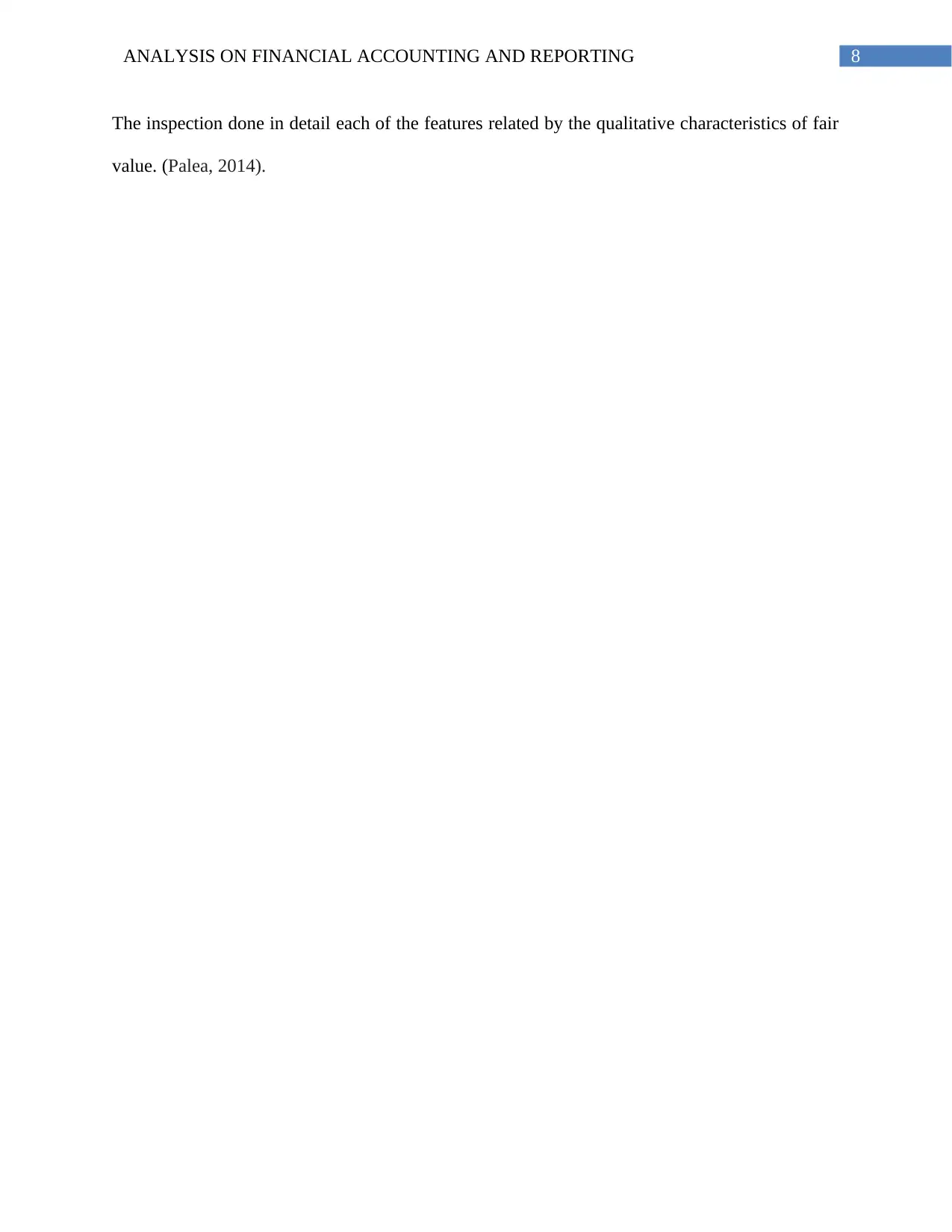
8ANALYSIS ON FINANCIAL ACCOUNTING AND REPORTING
The inspection done in detail each of the features related by the qualitative characteristics of fair
value. (Palea, 2014).
The inspection done in detail each of the features related by the qualitative characteristics of fair
value. (Palea, 2014).
⊘ This is a preview!⊘
Do you want full access?
Subscribe today to unlock all pages.

Trusted by 1+ million students worldwide
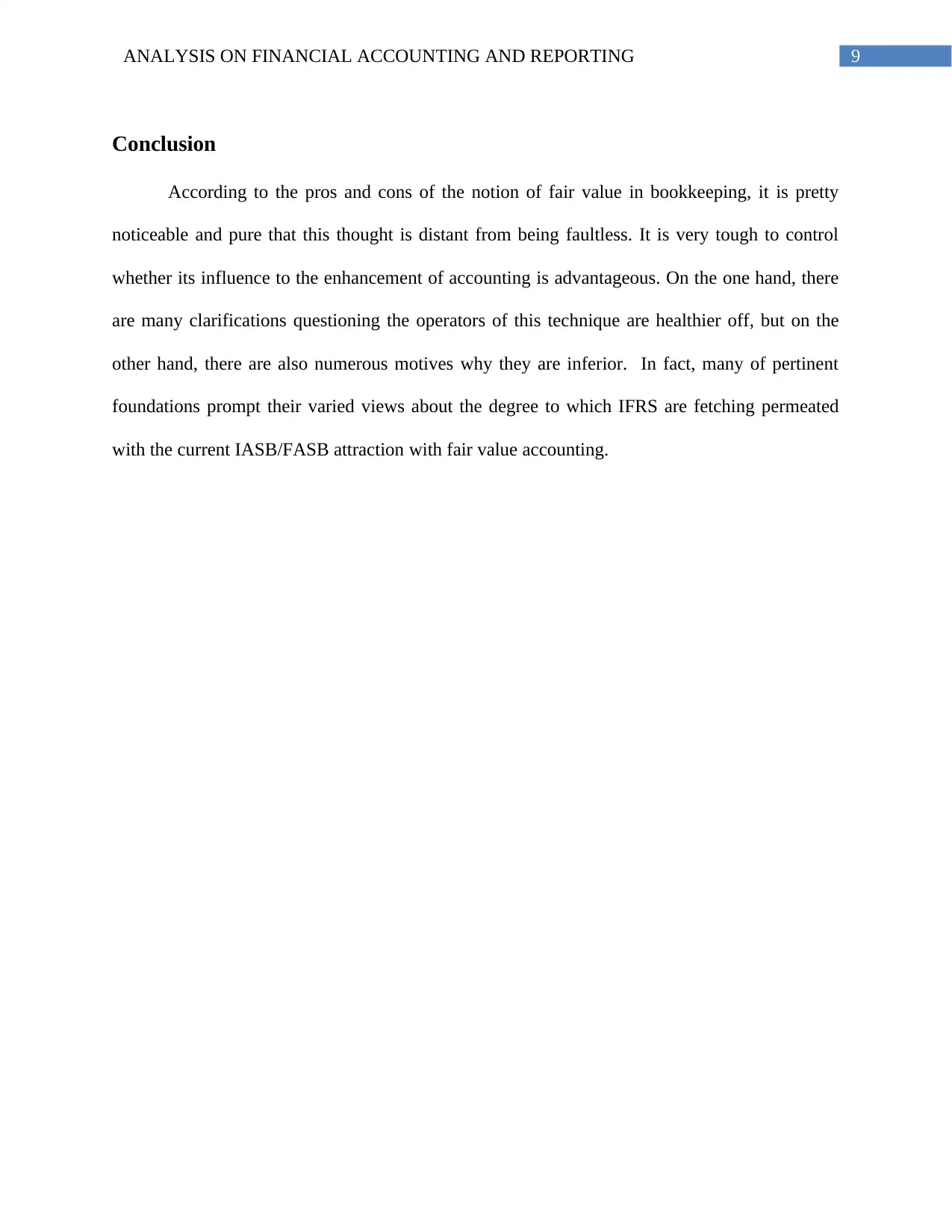
9ANALYSIS ON FINANCIAL ACCOUNTING AND REPORTING
Conclusion
According to the pros and cons of the notion of fair value in bookkeeping, it is pretty
noticeable and pure that this thought is distant from being faultless. It is very tough to control
whether its influence to the enhancement of accounting is advantageous. On the one hand, there
are many clarifications questioning the operators of this technique are healthier off, but on the
other hand, there are also numerous motives why they are inferior. In fact, many of pertinent
foundations prompt their varied views about the degree to which IFRS are fetching permeated
with the current IASB/FASB attraction with fair value accounting.
Conclusion
According to the pros and cons of the notion of fair value in bookkeeping, it is pretty
noticeable and pure that this thought is distant from being faultless. It is very tough to control
whether its influence to the enhancement of accounting is advantageous. On the one hand, there
are many clarifications questioning the operators of this technique are healthier off, but on the
other hand, there are also numerous motives why they are inferior. In fact, many of pertinent
foundations prompt their varied views about the degree to which IFRS are fetching permeated
with the current IASB/FASB attraction with fair value accounting.
Paraphrase This Document
Need a fresh take? Get an instant paraphrase of this document with our AI Paraphraser
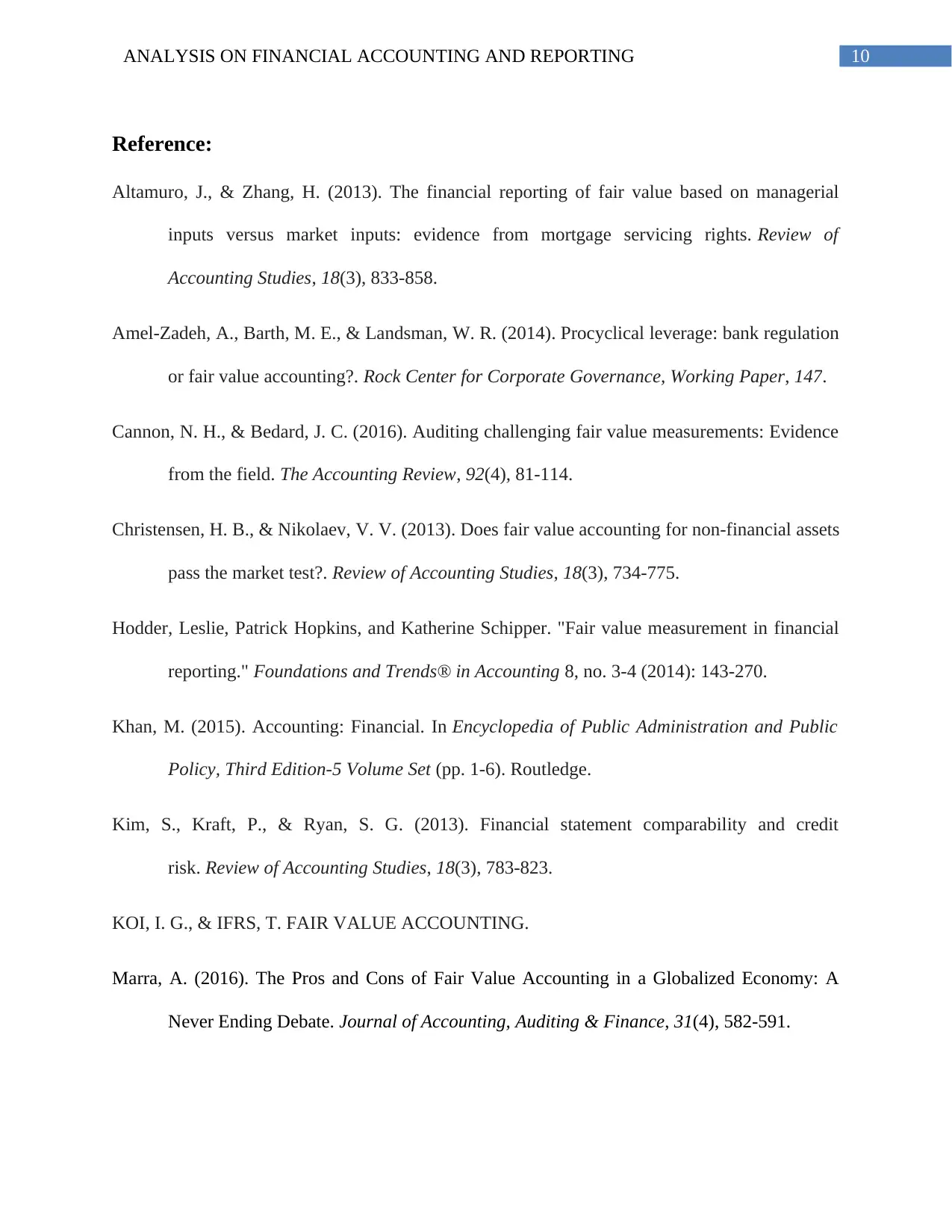
10ANALYSIS ON FINANCIAL ACCOUNTING AND REPORTING
Reference:
Altamuro, J., & Zhang, H. (2013). The financial reporting of fair value based on managerial
inputs versus market inputs: evidence from mortgage servicing rights. Review of
Accounting Studies, 18(3), 833-858.
Amel-Zadeh, A., Barth, M. E., & Landsman, W. R. (2014). Procyclical leverage: bank regulation
or fair value accounting?. Rock Center for Corporate Governance, Working Paper, 147.
Cannon, N. H., & Bedard, J. C. (2016). Auditing challenging fair value measurements: Evidence
from the field. The Accounting Review, 92(4), 81-114.
Christensen, H. B., & Nikolaev, V. V. (2013). Does fair value accounting for non-financial assets
pass the market test?. Review of Accounting Studies, 18(3), 734-775.
Hodder, Leslie, Patrick Hopkins, and Katherine Schipper. "Fair value measurement in financial
reporting." Foundations and Trends® in Accounting 8, no. 3-4 (2014): 143-270.
Khan, M. (2015). Accounting: Financial. In Encyclopedia of Public Administration and Public
Policy, Third Edition-5 Volume Set (pp. 1-6). Routledge.
Kim, S., Kraft, P., & Ryan, S. G. (2013). Financial statement comparability and credit
risk. Review of Accounting Studies, 18(3), 783-823.
KOI, I. G., & IFRS, T. FAIR VALUE ACCOUNTING.
Marra, A. (2016). The Pros and Cons of Fair Value Accounting in a Globalized Economy: A
Never Ending Debate. Journal of Accounting, Auditing & Finance, 31(4), 582-591.
Reference:
Altamuro, J., & Zhang, H. (2013). The financial reporting of fair value based on managerial
inputs versus market inputs: evidence from mortgage servicing rights. Review of
Accounting Studies, 18(3), 833-858.
Amel-Zadeh, A., Barth, M. E., & Landsman, W. R. (2014). Procyclical leverage: bank regulation
or fair value accounting?. Rock Center for Corporate Governance, Working Paper, 147.
Cannon, N. H., & Bedard, J. C. (2016). Auditing challenging fair value measurements: Evidence
from the field. The Accounting Review, 92(4), 81-114.
Christensen, H. B., & Nikolaev, V. V. (2013). Does fair value accounting for non-financial assets
pass the market test?. Review of Accounting Studies, 18(3), 734-775.
Hodder, Leslie, Patrick Hopkins, and Katherine Schipper. "Fair value measurement in financial
reporting." Foundations and Trends® in Accounting 8, no. 3-4 (2014): 143-270.
Khan, M. (2015). Accounting: Financial. In Encyclopedia of Public Administration and Public
Policy, Third Edition-5 Volume Set (pp. 1-6). Routledge.
Kim, S., Kraft, P., & Ryan, S. G. (2013). Financial statement comparability and credit
risk. Review of Accounting Studies, 18(3), 783-823.
KOI, I. G., & IFRS, T. FAIR VALUE ACCOUNTING.
Marra, A. (2016). The Pros and Cons of Fair Value Accounting in a Globalized Economy: A
Never Ending Debate. Journal of Accounting, Auditing & Finance, 31(4), 582-591.
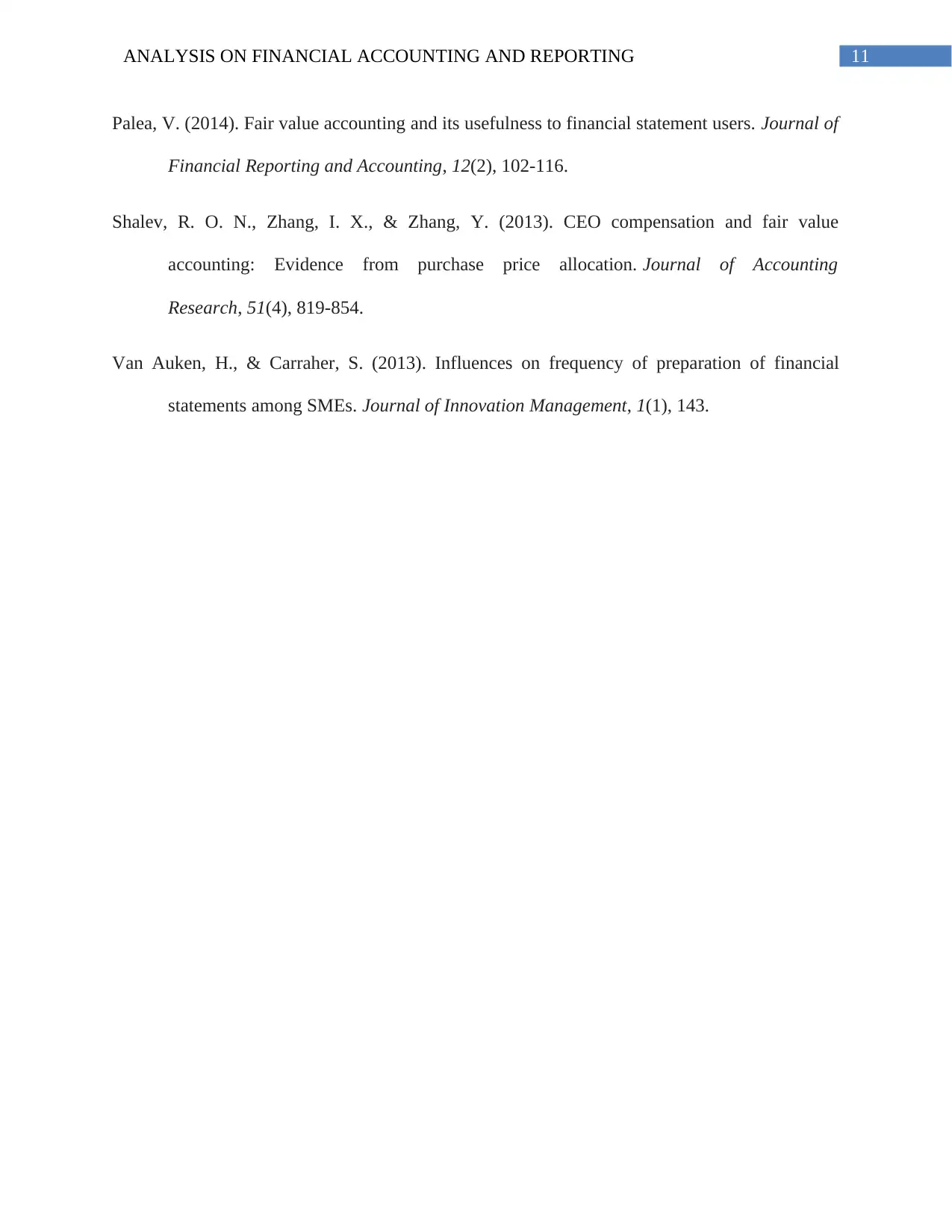
11ANALYSIS ON FINANCIAL ACCOUNTING AND REPORTING
Palea, V. (2014). Fair value accounting and its usefulness to financial statement users. Journal of
Financial Reporting and Accounting, 12(2), 102-116.
Shalev, R. O. N., Zhang, I. X., & Zhang, Y. (2013). CEO compensation and fair value
accounting: Evidence from purchase price allocation. Journal of Accounting
Research, 51(4), 819-854.
Van Auken, H., & Carraher, S. (2013). Influences on frequency of preparation of financial
statements among SMEs. Journal of Innovation Management, 1(1), 143.
Palea, V. (2014). Fair value accounting and its usefulness to financial statement users. Journal of
Financial Reporting and Accounting, 12(2), 102-116.
Shalev, R. O. N., Zhang, I. X., & Zhang, Y. (2013). CEO compensation and fair value
accounting: Evidence from purchase price allocation. Journal of Accounting
Research, 51(4), 819-854.
Van Auken, H., & Carraher, S. (2013). Influences on frequency of preparation of financial
statements among SMEs. Journal of Innovation Management, 1(1), 143.
⊘ This is a preview!⊘
Do you want full access?
Subscribe today to unlock all pages.

Trusted by 1+ million students worldwide
1 out of 12
Related Documents
Your All-in-One AI-Powered Toolkit for Academic Success.
+13062052269
info@desklib.com
Available 24*7 on WhatsApp / Email
![[object Object]](/_next/static/media/star-bottom.7253800d.svg)
Unlock your academic potential
Copyright © 2020–2025 A2Z Services. All Rights Reserved. Developed and managed by ZUCOL.




